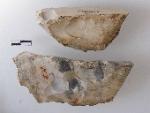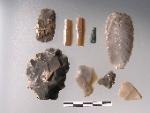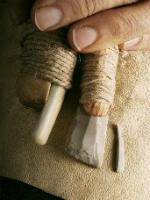Lithic production concepts
in the palaeo-Eskimo cultures of Greenland
- A diachronic investigation of the lithic industry in Saqqaq, Dorset, Independence I and II
By Mikkel Sørensen

Palaeo-Eskimo artefacts has, so far, primarily been analysed by morphology, which have resulted in typological definitions of the palaeo-Eskimo cultures. The crucial question that this project poses challenge this perception by asking: does our generally accepted typologically defined palaeo-Eskimo cultures reflect "true" Eskimo cultures, or should they rather be understood as archaeological constructions?

The methodology of the project is based on the theory of the "chaîne opératoire" explained as the life cycle of the artefacts from procurement of raw material, to tool production, use, reuse and the final discard of the tools. To interpret and explain different "chaînes opératoires" the artefact material will be analysed by: a) refitting the artefacts, b) replicative studies and c) dynamical classification of the lithic material. Further more a technological examination of the Arctic knapping tools will be undertaken.

By analysing the "chaînes opératoires" on a representative selection of sites from Saqqaq, Dorset, Independence I and II, different lithic production concepts in the Eastern Arctic will be explained. And by a following diachronic comparison of the concepts, it will be possible to discuss and define technological traditions (techno-complexes), which will reflect prehistoric traditions, in the Eastern Arctic.
Examples of preliminary conclusions drawn from the project are: That there is no transition in technology between Saqqaq and Dorset 1 in West Greenland and it is therefore unlikely that Saqqaq develop into Dorset in West Greenland. Dorset 1 and Independence II have the exact same concepts of lithic productions and these two "groups" must therefore be perceived as parts of the same culture, called "Greenlandic Dorset". The Thule area is characterized by a much more diverse history than rest of Greenland, in this area technologies typical to six Palaeo-Eskimo groups have been identified (Independence I, Saqqaq, Pre-Dorset, Greenlandic Dorset, Canadian Early Dorset, Late Dorset).
Fieldwork has this year been carried out in Nuuk, as achieve studies of artefacts, mainly from East and Northeast Greenland.
Publications

Sørensen, M.; Andreasen, C. (2004) Ekspedition "Geo-Ark". Arkæologisk rekognoscering af området Wollaston Forland. [Expedition ”Geo-Ark”. Archaeological survey of Wollaston Forland, Northeast Greenland]. Rapport fra Nationalmuseet, København og Grønlands Nationalmuseum og Arkiv, Nuuk.
Sørensen, M.; Pedersen, K.B. (2005) "Killiaq kilden på Nuussuaq: på sporet af Saqqaqkulturens redskabssten. [The Killiaq Outcrop on Nuussuaq: Searching for Saqqaqs lithic raw materials] Tidskriftet Grønland nr 2-3: 105-19.
Sørensen, M. (in press) The Chaîne Opératoire Applied to Arctic Archaeology. Conference Proceedings: Dynamics of Northern Societies, Copenhagen, SILA/NABO.
Sørensen, M.; Grønnow, B. (in press) Palaeo-Eskimo Migrations into Greenland: The Canadian Connection. Conference proceedings: Dynamics of Northern Societies, Copenhagen, SILA/NABO.